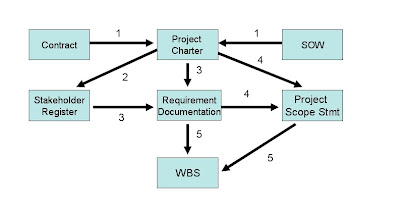In the previous chapter, we saw how to create the WBS. Since the WBS is an important artifact, it would be better if we take a look at it with some more details.
So, lets get started!!!
Creating the WBS:
Even though we looked at how to create the WBS in great detail, it would make it easier for you to understand the whole process if we have another picture to explain it. Below is a picture that explains how the WBS is created.
In the picture above, each of the boxes is a document/artifact and arrows indicate the direction in which data flows. The numbers indicate the order in which data flows. For ex: The contract and the SOW are inputs to create the Project Charter. Similarly the Project Charter is an input to create the Stakeholder Register and these two together are inputs to the Requirement Documentation step and so on.
The WBS is at the heart of project management. It affects directly or indirectly almost all the processes that are performed after its creation.
Processes Based on the WBS:
As part of managing the project, there are many processes that are directly based on the WBS as part of the Scope Baseline. They are:
1. Cost Estimation
2. Quality Planning
3. Risk Identification
4. Procurement Planning
5. Defining Activities for Project Schedule
6. Budget Determination
Let us look at a diagram to understand this better.
The three most important things you need to understand about Project Scope Planning are:
• You need to collect requirements by using the Collect Requirements process before you can define the project scope.
• The requirements documentation generated by the Collect Requirements process and the project charter generated during the project initiation are used to define the scope, which is documented in the project scope statement.
• The requirements documentation and the project scope statement are input items to create the work breakdown structure (WBS), which is a breakdown of project deliverables into manageable pieces called work packages. The WBS is supported by another document called the WBS dictionary, which offers details for the WBS components.
Previous: Creating the WBS
Next: Summary - Project Scope Planning
Monday, May 16, 2011
Chapter 32: Before and After the WBS
Subscribe to:
Post Comments (Atom)
© 2013 by www.getpmpcertified.blogspot.com. All rights reserved. No part of this blog or its contents may be reproduced or transmitted in any form or by any means, electronic, mechanical, photocopying, recording, or otherwise, without prior written permission of the Author.
Followers
Popular Posts
-
So far, we have been talking in terms of projects only. There are two other terms that are closed linked with projects and project manageme...
-
In the previous chapter , we took a look at Expected Monetary Value or EMV Analysis . The Decision Tree Analysis is another tool/technique ...
-
In the previous chapter, we saw how to create the Project Scope Document. The next step in planning for a projects scope is to create the Wo...
-
In the previous chapter, we saw the project lifecycle in detail. In this chapter, we are going to take a look at the Project Management Kno...
-
In the previous chapter we learnt how to create the project human resource plan. To get resources you need to spend money (Cost) and you can...
-
In the previous chapter , we learnt the basic details about Continuous Distributions. In this chapter, we are going to take a detailed look...
-
In the previous chapter we learnt that the risk register is going to be constantly updated as we progress through the various processes in...
-
Expected Monetary Value Analysis or EMV Analysis in short is the 2nd tool and technique in the Quantitative Risk Analysis and Modeling Tech...
-
In the previous chapter, we saw that an organizations policies and culture can have a significant impact on a project. Towards the end we al...
-
In the previous chapter, we took a look at how to sequence the activities based on the requirements and dependencies. The next step would be...











No comments:
Post a Comment